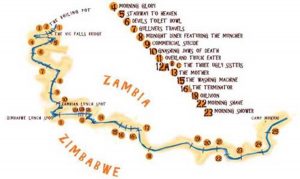Jambo Africa: We smell the bush!
Africa, the second-biggest continent, measures from north to south 8,000 km, from east to west 7,600 km. It spans an area of 30.3 m km², which equals about 20% of the earth’s landmass. About 13% of the world’s population, 760 million people live here. Africa is part of the old Gondwana, which encompassed also South America, the Arabian Penisula, India, and Australia (continental drift).
Finally Crossing the Equator again
In September 1989 we’re off to Johannesburg, South Africa, with SAL, Suid Afrikaanse Lugdiens/South African Airways via Sal, Ilha do Sal (Cape Verde). 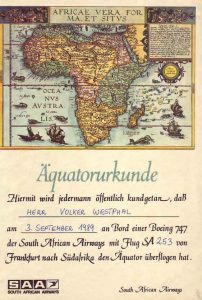 The Boeing 747 SP, the shortened version of the trusted jumbo jet, would be able to make it in a nonstop flight, but it’s too small for this flight. Which means: landing and refuelling. The Isles of Cape Verde are at this point in history a military station for the Soviet fleet in the Atlantic. It is part of earning a living there. Until the end of the apartheid regime in 1994, the South African airline won’t receive landing or refuelling rights in any Sub-Saharan country.
The Boeing 747 SP, the shortened version of the trusted jumbo jet, would be able to make it in a nonstop flight, but it’s too small for this flight. Which means: landing and refuelling. The Isles of Cape Verde are at this point in history a military station for the Soviet fleet in the Atlantic. It is part of earning a living there. Until the end of the apartheid regime in 1994, the South African airline won’t receive landing or refuelling rights in any Sub-Saharan country.
Our destinations in the Republic of South Africa are Johannesburg, Pretoria and Durban as well as the game reserves Krüger Park, Sabi Sabi and Hluhluwe. We want to get the Big Five (cape buffalo, elephant, leopard, lion and rhinoceros) in front of our camera lenses. On this trip, numerous slide films are exposed successfully.
Through Namibia, Zimbabwe and Botswana in a Land Rover and tent
November 1989: 6 people, 1 Land Rover and 4 tents: Johannesburg, Rustenburg, Augrabies, Kalahari Gemsbok Park, Sesriem, Sossusvlei, Walvis Bay, Swakopmund, Windhuk, Wardap, Rehoboth, Gobabis, Ghanzi, Maun, Kasane, Chobe, Victoria Falls, Savuti Channel, Moremi, Makgadikgadi-Pan, Gaborone & Johannesburg. 60 slide films are photographed. 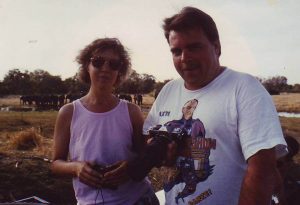 On November 10, while in the Café-Restaurant Gathemann in Windhoek in Kaiser-Wilhelm-Straße (today Independence Avenue), I read in the local newspaper about the fall of the Berlin Wall the day before, and cannot believe it. I call my dear Annegret in Hamburg, Germany, who happily confirms the sensational news. That is going to be the last phone call for a long time. Cell phone“s age has not begun. Here in Windhoek we gather supplies for the long drive through Botswana back to Johannesburg.
On November 10, while in the Café-Restaurant Gathemann in Windhoek in Kaiser-Wilhelm-Straße (today Independence Avenue), I read in the local newspaper about the fall of the Berlin Wall the day before, and cannot believe it. I call my dear Annegret in Hamburg, Germany, who happily confirms the sensational news. That is going to be the last phone call for a long time. Cell phone“s age has not begun. Here in Windhoek we gather supplies for the long drive through Botswana back to Johannesburg.
Following Dr. Livingstone’s footsteps – in an Unimog
In November 1991, our tent safari through southern Africa begins. Our meeting point is Frankfurt/Main airport. Annegret owns a ticket by SAL/SAA – status AD75, which means she has a confirmed seat reservation. Cord and Volker both have a SAL/SAA ticket, status ID90 (standby). That is how Annegret gets through check-in, but the boys are denied: the SAL/SAA flight is overboo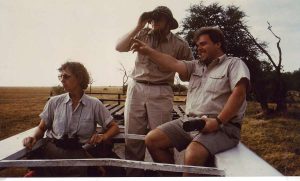 ked. At short-notice two flights have been combined. Now it’s time for improvisation. Despite our separate flights, Annegret has all our luggage amounting to about 90 kg. Each of the gentlemen only carries a piece of hand luggage. When Annegret’s flight is off-block, it’s hard to know what to do. The day after tomorrow our tent safari Is scheduled to start from Victoria Falls in Zimbabwe. That’s when we discover a nonstop flight to Windhoek by Air Namibia in about an hour. We ask to be taken onboard with our ID90 tickets. A friendly colleague of the airline shows understanding for our situation and hands us two boarding passes. Though it’s not quite within the limitations of his orders, he keeps two seats for us and ushers us unseen through security – the last two seats in the Boeing 747 SP are ours. We made it! This shortened version of the jumbo makes it without a fuel stop to Windhoek, and so we overtake Annegret’s bigger Jumbo which has to refuel on the way. Next morning we land in Windhoek and are supposed report at the city office of Namib Air in order to get our FOC transport to Johannesburg organized. We manage without any problems: 4.5 hours later we touch down at our final destination Jo’anna Intl. (Jan Smuts Apt.) after Annegret’s arrival.
ked. At short-notice two flights have been combined. Now it’s time for improvisation. Despite our separate flights, Annegret has all our luggage amounting to about 90 kg. Each of the gentlemen only carries a piece of hand luggage. When Annegret’s flight is off-block, it’s hard to know what to do. The day after tomorrow our tent safari Is scheduled to start from Victoria Falls in Zimbabwe. That’s when we discover a nonstop flight to Windhoek by Air Namibia in about an hour. We ask to be taken onboard with our ID90 tickets. A friendly colleague of the airline shows understanding for our situation and hands us two boarding passes. Though it’s not quite within the limitations of his orders, he keeps two seats for us and ushers us unseen through security – the last two seats in the Boeing 747 SP are ours. We made it! This shortened version of the jumbo makes it without a fuel stop to Windhoek, and so we overtake Annegret’s bigger Jumbo which has to refuel on the way. Next morning we land in Windhoek and are supposed report at the city office of Namib Air in order to get our FOC transport to Johannesburg organized. We manage without any problems: 4.5 hours later we touch down at our final destination Jo’anna Intl. (Jan Smuts Apt.) after Annegret’s arrival. 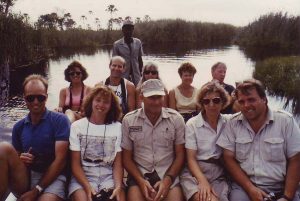
It’s a logistical feat paired with an appropriate amount of luck. We manage to arrive on time (again by plane) at our safari meeting point at the Victoria Falls. In our luggage there are about 30 slide films.
Like being inside the drum of a washing machine
„White Water Rafting“ (Shearwater video link) near the Victoria Falls in Zimbabwe attract wild water crazies from all over the globe
The Batoka Gorge lies below the Victoria Falls in Zambabwe. When the wild waters of the Zambezi calm down again after their gigantic drop of 108 metres on a width of 1,600 metres, this is where a unique adventure with the natural powers begins.
“White Water Rafting” on the Zambezi (with 2,700 kilometres the fourth longest river in Africa) is a perfectly organized spectacle lasting one day, which attracts wild water crazies from all over the world to the southern African country. 20,000 people came in 1992, in 1993 the number is expected to be 30,000. The adventure in over five metre long rubber dinghies takes place between the 4th and the 19th rapid after the waterfalls. The river has carved itself into the gorge and pronounced currents, eddies, and walls of waves (level of difficulty for wild water rafters: 3 to 5) have developed. On this tour you will also encounter, the highest level, 6, which is unable to handle in a rubber dinghy. In this case it is a narrow canal perched between rugged rocks, which appears like the drum of a washing machine. It has been taken off the tourists’ arrangement. Instead, the boat is carried across land at this leg of the tour. To navigate through it would be commercial suicide for the companies (hence the name of the rapid; deathly accidents cannot be ruled out).
However, before entering on this adventure, the rafting company (the most experienced one, headquartered in Victoria Falls, is called Sheawater) makes you sign a declaration of agreement, so as to assume no liability in case of injuries or loss of life. As a matter of fact, throughout its now 13-year history of Zambezi rafting there has only been one mortal accident. One in every 500 clients encounters serious, but minor injuries. Recently, wearing a helmet while on the Zambezi has become compulsory.
Every boat is staffed with an experienced oarsman with 250 hours of experience on the river or a six week instruction course. All of them are all adventure-seeking, fit guys from South Africa, New Zealand, Australia or Zimbabwe who jumped into this business. Errol Bredenkamp from Kimberley in South Africa is the boss of this group. A man who inspires trust and respect, and who has an almost intimate relationship with each and every rapid. He knows exactly how to ideally steer towards it if you want to take it in a sporty way and be brought out of it. He takes his time in order to instruct – like in our case – the 50 or so candidates from all over the world. And he leaves no doubt that his words can be a matter of survival. He dramatizes in a tone of understatement: “I tell you, you’ll be dissolved from all the water. The waves crashing above you are as high as the five-metre tree over there. Sometimes you’ll be underwater in your boat for five seconds. If you are thrown overboard or boat capsizes, which may well happen, don’t panic. Keep your eyes open, orientate yourselves, makes sure you know where you are and where the boat is. Most importantly, don’t ever hold onto the rocks or fight against the current.  Let yourselves drift, keep your legs towards your body to cushion yourselves. In quiet, sandy inlets watch out for crocodiles and avoid them!!! You can be sure we’ll get you out. You still have a chance now to say goodbye to the group and leave. But by the end of this I’ll guarantee that 99,9 percent of you will say it was the greatest thing they’ve ever done!”
Let yourselves drift, keep your legs towards your body to cushion yourselves. In quiet, sandy inlets watch out for crocodiles and avoid them!!! You can be sure we’ll get you out. You still have a chance now to say goodbye to the group and leave. But by the end of this I’ll guarantee that 99,9 percent of you will say it was the greatest thing they’ve ever done!”
Anxious faces accompany his talk. Nobody asks questions. Silence. Everyone is a little bit neasy but no one chickens out. Everyone hears their heartbeat underneath the close-fitting life vest. But it is also the majestic beauty of the wild gorge that takes our breath away, in particular when crocodiles (who avoid fierce currents) are sunbathing on the river banks or eagle-like birds of prey (among them the very rare Taita falcon) are circling above the warm waters in the shimmering noon heat.
Normally, it is unavoidable that the boat capsizes at the tricky rapid no. 18 (bearing the name Oblivion). Here, accelerating and slowing powers meet in a cauldron of waves and eddies. In that case neither steering manoeuvres nor shifting of weight will be of help. The rubber dinghy shoots into a five metre deep water hole, takes off like a kite in the wind and topples backwards with its seven-people crew. Nobody is able to hold onto the boat at this point. But the skilled oarsman is taking it all coolly. He turns around his boat in the manner of a surfer and collects his crew by way of shouting out commandos. To whoever has drifted the farthest, he throws out a lifeline. The water itself calms down quickly and, once you’re actually in it, you can let yourself drift quite “relaxed” until you are picked up again.
But capsizing can happen at any other rapid, too, if you are unprepared and underrate the whirling powers of the water. The most difficult task of the entire trip, however, will happen at the very end when you put foot on land again: torturing yourself up on slippery steps taking you 250 metres through a canyon – and are then handed an ice-cold drink.
South of the Zambezi: smoke that thunders
Jambo Africa! Now it’s getting serious
We start our Rover safari with the early flight from Johannesburg to Victoria Falls. It’s the country’s main attraction but at first sight the place seems rather sleepy. However, not far from the centre of town there is one of the most beautiful hotels in all of Zimbabwe.
And only two kilometres away the natural wonder awaits us: roaring noisily, a wall of water plummets down 108 metres into the narrow gorge. Amazing! The spray blows up in a dense mist up to the edge of the canyon, irrigating a small rainforest with magical ferns and wild flowers. The Kololo people who live here call the falls Mosi oa tunya: smoke that thunders. There are no fences or shops that mar this natural spectacle. 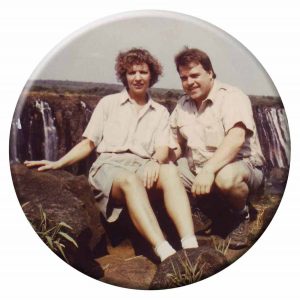 Only a small path leads up to the edge. There is just one thing that could disturb sensitive souls in the face of nature’s grandeur: helicopters rattling through the air one after another that offer tourists an “angel’s flight”. After a while, though, the noise of modern technology is drowned out by the mighty roar of the Zambezi plummeting into the Batoka gorge.
Only a small path leads up to the edge. There is just one thing that could disturb sensitive souls in the face of nature’s grandeur: helicopters rattling through the air one after another that offer tourists an “angel’s flight”. After a while, though, the noise of modern technology is drowned out by the mighty roar of the Zambezi plummeting into the Batoka gorge.
Not only are these the most famous waterfalls of the planet, Victoria Falls is also the centre for all travellers who love an adrenaline shot: The world’s highest bungee jump off a bridge (110m) is as much part of it as the most dangerous wild water rafting on the Zambezi, which has cost a few tourists their lives. Still, or because of it, this trip is one of the most sought after in the entire country. I would like to try it and persuade my co-travellers Annegret and Cord to join me.
Swirling adventure
After a quick theoretical instruction in front of our hotel we head off in a bus and a short time afterwards we slide into the huge rubber rafts. I ask our black boatsman how long a Zambezi training may take, imagining it must be about two years. His answer (“Four weeks, sir!”) makes us go pale. The only thing that can save us now is a prayer to Nyaminyami, the Zambezi River God, and off we go.
Like a big white wall the first of the rapids builds up in front of us, swallows us and spews out the boat and everything in it. Everyone’s still on board. Next time, we are a little less lucky. With all my might I clutch the rope, fight against the raging current. Water shoots up my nose and mouth. The capsized boat is stuck in a rapid. Whatever happens, always hang on to the boat is what the guides have drilled into us. I try to follow their orders until I feel, despite my bent legs, the gargling and foaming water ripping off my shorts and underpants. As both are hanging around my right ankle, I let go
Better drown than return into the boat without any pants. I shoot through the next rapid, manage to get back in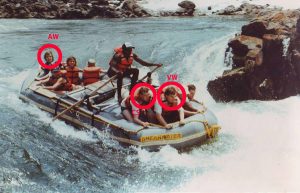 to the pants, not without swallowing a proper amount of Zambezi water. If the saying is true that everyone who ever drinks Zambezi water will return, I would need to build a romantic block house by the river banks immediately.
to the pants, not without swallowing a proper amount of Zambezi water. If the saying is true that everyone who ever drinks Zambezi water will return, I would need to build a romantic block house by the river banks immediately.
When I get put my head out of the water again, I try to orientate myself. Legs bent close to the body so as to avoid injuries from my rocky surroundings, I jet downstream, leaving our raft far behind. Excitedly and still in good spirits I wave goodbye and am curious what will come next. After a few hundred metres the roaring river makes a sharp right bend and on the left I see a sandy little bay. Standing there is a kayaker lassoing a thing leash with a leather weight on its end. He aims at me and throws the vital connection to me. Perfect aim! The small leather-bound weight bang right into my forehead, I see about a thousand stars, almost lose all senses, again swallow a lot of water, but manage to hold onto the leash and of course don’t let go of it!
Bottom-less
Half-numb, I’m fished out of the water and lie puffing and blowing on the secure shore. I don’t have much time to compose myself because the rest of the crew has turned the raft around, got back on and is now steering towards my shore with curiosity to get me back aboard.
Our next rapid is laughable in comparison and our optimism increases, only to be abruptly traded in for sheer horror. Hell, hell is what’s awaiting us now. This cannot and will not go down well! That’s it. Over, out, goodbye. Our eyes search desperately in the face of the oarsman. He has a lot to do now. He wedges himself into the aluminium frame of 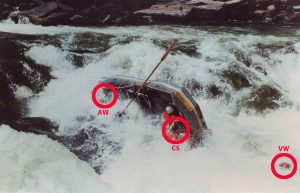 the raft, seizes up the oars so that they won’t break on the dangerously close rocky shore. No more time to hold hands. Too late! Full throttle into hell. Whatever, we signed on to this of our own free will. Then the rubber raft rears up. All of us are thrown out into the river. A short, loving thought goes out to my friends and again, I’m on my way down-stream, swallowing water and gasping, through the hellish waters towards the mouth of the river in Mozambique, shortly before Madagascar. Oh great, hello shark!
the raft, seizes up the oars so that they won’t break on the dangerously close rocky shore. No more time to hold hands. Too late! Full throttle into hell. Whatever, we signed on to this of our own free will. Then the rubber raft rears up. All of us are thrown out into the river. A short, loving thought goes out to my friends and again, I’m on my way down-stream, swallowing water and gasping, through the hellish waters towards the mouth of the river in Mozambique, shortly before Madagascar. Oh great, hello shark!
Jetting helplessly through the wild waters I remember another tip of the boat people: if you fall into the water, never ever swim towards the shore, because that’s where the notorious Zambezi crocodiles sunbathe. As soon as that thought enters my head, an extremely agile one-man kayak cuts off my route: “Everything ok?” Mostly American wildwater cracks accompany the unwieldy rafts in order to step in emergencies or to get out of the water and film the chaos on video which can be bought after the tour. A truly merry souvenir. In case of severe accidents they alert the rescue helicopter that is supposed to arrive within minutes.
This time we get off easy. There is an Englishman, who doesn’t belong to our group, who is not as lucky, though. Without his pants, the ashamed misadventurer is being hauled back aboard, mooning his co-travellers. And the spectacle is indeed reminiscent of a full moon. He complains bitterly that the women do not care to avert their eyes, even though the shock of the cold water does not leave much to avert one’s eyes from.
In the last rapid of the day the rubber raft roars upwards one more time, stands vertically in the water, and then does a backflip. I have no idea which way is up and which is down, feel I am underwater endlessly. My shorts I have tied fast, but I do lose my shoes. Really wiped out, but proud and happy we arrive at our destination, rapid no. 19, in the afternoon.
We hobble up the steep canyon path. I can actually be glad, others have been dealt tougher lots in the rapids. Many are limping, others have bruises. Annegret almost drowned and has black and blue marks all over her body; and even still wants to foreswear life altogether! Cord is barely noticeable anymore. In return, the cool Zambezi Beer we are offered at the top of the canyon is truly divine. What a day!
The Zambezi trip degrades all similar adventures on the Colorado River in the USA or my rapid ride on the Shotover River (Queenstown, New Zealand’s South Island) to harmless promotional trips. Rapids are internationally classified on a scale from 1 to 6, with 6 meaning it is impassable. That is why at rapid no. 9 (“commercial suicide”) the raft is carried out of the water and along the rocky shore. During low tide, all rapids of the Zambezi are category 5+.
Game in town
On our way to the hotel, buffalos cross our road. In front of the fast food restaurant Wimpy an adult wart hog dashes around the corner, in the centre of Victoria Falls we chance upon a herd of elephants crushing into the fence of the Makasa Sun Hotel, to get to the lush green of the hotel garden. Perhaps the elephants can sense that the hotel is in dire need of some renovation work. Noisily, the accurately trimmed trees crush on the English lawn. Dozens of tourists gather only metres away from the animals to capture this scene on their pocket cameras, oblivious of the fact that their lives are in danger – any minute, one of the agitated elephants could attack. Two hours later, the herd retires.
Baboons, as we observe shortly afterwards, are even more obtrusive. The warning sign in the rooms – “Please keep your windows closed at all times” – is meant seriously. Just as we open the door, two relatively large monkeys squeeze through the half-open window and charge across the bed and wardrobes. Baboons are said to be rather aggressive, their knife-sharp teeth notorious. Which is why we close the door from the outside to give the monkeys more time o ravage through the room.
At the reception desk, the nice lady asks me if I suffer from jaundice. When I look at her totally flabbergasted, she apologizes. “You know,” she explains, “a baboon stole a medicine box from one of the rooms and put in back down in another. Our hotel physician identified it as a hepatitis drug. Now I’m asking all our guests if they have jaundice because the drug is obviously needed!”
Rafting the Zambezi
The Zambezi is renowned for its extremely high volume and steep gradient – treat it with respect!
-
- The 3 „Minus rapids“: Occur before the official #1. Minus #1 and #2 are the only rapids that have been run, minus #3 is impossible to access because of its proximity to the falls. Rapid #2 is the biggest and most impressive rapid on the river.
-
- Rapid # 1: „…against the wall“, Class 4/5: The Boiling Pot, accessible only from the Zambian bank, is the start of the low water trip. From here the river hits a wall forming a wild cushion wave and eddy.
-
- Rapid # 2: „…the bridge“, Class 3: A wild mixture of waves best in the early part of the low water season. Clearly visible to bungee jumpers and spectators on the Victoria Falls bridge.
-
- Rapid # 3: Class 4: A steep and radically fast wave with an easily avoidable hole. The second part of this rapid is best in the early part of the season – a small wave train with an excellent pocket on the Zambian side.
-
- Rapid # 4: „Morning Glory“, Class 4/5: The first major rapid offering varying lines with an almost river wide hole at the top, followed by a few diagonals off the right hand wall and finally a big hole at the bottom.
-
- Rapid # 5: „Stairway to Heaven“, Class 5: Best in the early part of the season, with an 8m drop over 10m, very steep and powerful with a heap of massive waves and holes. Although it isn“t too technical, it“s size and volume make for an amazing spectacle and an even more amazing ride. Avoid the waterfalls and a hole on the left called the „catcher“s mitt“ plus a large pourover on the right.
-
- Rapid # 6: „Devil“s Toilet Bowl“, Class 4: A Short rapid with a deceptively steep and powerful hole on entry followed by some nasty boils and whirlpools.
-
- Rapid # 7: „Gullivers Travels“, Class 5: A very respectful 700m of class 5 high volume white water at certain levels. This is the longest and most technical rapid on the one day whitewater trip. The run consists of a main channel with smaller channels feeding into it – includes the „Temple of Doom“, „The Crease“, „Patella Gap“ and „Land of the Giants“.
-
- Rapid # 8: „Midnight Diner“, Class 3/5: This rapid has 3 runs. On the left is „Star Trek“ with a hole of up to 5m reserved for the brave. The „Muncher Run“ in the centre takes you through a window of „Star Trek“. On the right is the „Chicken Run“.
-
- Rapid # 9: „Commercial Suicide“, Class 5/6: The Zambezi“s most infamous. This is a river-wide pour-over with a very narrow slot of less than a metre on the right – commercial portage!
-
- Rapid #10: „Gnashing Jaws of Death“, Class 4: An easy run before lunch…..
-
- Rapid # 11: „Overland Truck Eater“, Class 5: A big barrel for about two weeks in the year during the transition between high and low water in mid January and early July. Watch out for the hole, eddy line and whirlpool. This is the first rapid on the „high water“ run.
-
- Rapid #12 A,B,C: „Three Sisters“ Class 3/4: 12B is the famous Zambezi surfing wave for kayakers – surfs best between August and December with two windows and a massive green shoulder and a big eddy. Rafters prefer the term „three little pigs“.
-
- Rapid # 13: „The Mother“, Class 4/5: A massive wave train at its best, first 3 waves super fast.
-
- Rapid # 14: Class 3: Big S-bend in the river. Center chute to be avoided at lower water levels.
-
- Rapid # 15: „Washing Machine“ Class 5: Simple wave train but un-runnable in the middle because of a huge crashing hole – go left or right into the eddy.
-
- Rapid # 16: „The Terminators I and II“, Class 4: A massive wave train and trough at higher levels, not much when low.
-
- Rapid # 17: „Double Trouble“, Class 5: A simple wave train but un-runnable because of 2 large holes – also known as „The Bitch“.
-
- Rapid # 18: „Oblivion“, Class 5: Three waves make up THE rapid on the Zambezi.. The 3rd crashing wave is responsible for more raft flips than any other in the world – only about 1 in 4 attempts succeed! This rapid marks the end of the „low water“ one-day run.
-
- Rapids #19 to #25: Class 2/3: Easy runs at the end of the day. Rapid #23 is the last rapid on the „high water“ one-day run.
Tomorrow we’re off in a Land Rover to meet free-living game in the neighbouring Botswana.
Raft and river photos: waterproof single-use camera
South Africa German PDF-version under Interactive/Downloads
Written by ABTS + Volker Westphal

